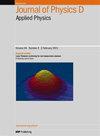Biochemical evaluation of wound healing efficacy of cold plasma-conditioned media under different operational conditions
IF 3.1
3区 物理与天体物理
Q2 PHYSICS, APPLIED
引用次数: 0
Abstract
Wound healing is a dynamic and intricate biological process crucial for tissue repair and regeneration. This study explores the potential therapeutic impact of non-thermal plasma generated by a hand-held cold atmospheric pressure plasma jet (C-APPJ) source on fibroblast cells (NIH/3T3) in vitro. The sequential phases of wound healing—inflammation, cell proliferation, and tissue remodelling, were assessed in the context of cell migration and oxidative stress dynamics. Typically, plasma generates a mixture of several reactive oxygen/nitrogen (ROS/RNS) species. The present study investigates the safety and efficacy of C-APPJ under distinct operating conditions (argon (GI) and argon + nitrogen (GII)) and exposure times (1 min and 3 min). Cell viability assays confirmed the non-cytotoxic nature of the cold plasma conditioned medium. The levels of ROS/RNS and malondialdehyde (biomarker of oxidative stress) in the plasma-treated samples remained comparable with the control fibroblast cells grown in normal media, suggesting the favourable modulation of ROS by the cellular antioxidant mechanisms. Accelerated wound-closure rates from 6th hour to 24th hour in all the treated groups ranged from 38.76% to 45.66%, when compared to 34.25% in the control cells. Substantial cell migration leading to 51.59% of wound closure was recorded in the argon + nitrogen (GII) group exposed for 3 min. Taken together, the potential of cold plasma to effectively heal wounds without causing prolonged oxidative stress and chronic inflammation is implicated. These outcomes suggest scope for clinical application of C-APPJ as safe and cost-effective treatment of wounds (ulcers, burns, diabetic foot) and wound disinfection.不同操作条件下冷等离子调节介质伤口愈合功效的生化评估
伤口愈合是一个动态而复杂的生物过程,对组织修复和再生至关重要。本研究探讨了手持式冷大气压等离子体射流(C-APPJ)源产生的非热等离子体对体外成纤维细胞(NIH/3T3)的潜在治疗作用。在细胞迁移和氧化应激动态的背景下,对伤口愈合的连续阶段--炎症、细胞增殖和组织重塑进行了评估。通常,血浆会产生多种活性氧/氮(ROS/RNS)的混合物。本研究调查了 C-APPJ 在不同操作条件(氩气(GI)和氩气+氮气(GII))和暴露时间(1 分钟和 3 分钟)下的安全性和有效性。细胞活力测定证实了冷等离子调节介质的无毒性。经血浆处理的样本中的 ROS/RNS 和丙二醛(氧化应激的生物标志物)水平与在正常培养基中生长的对照成纤维细胞相当,这表明细胞抗氧化机制对 ROS 起着有利的调节作用。从第 6 小时到第 24 小时,所有处理组的伤口闭合率都在 38.76% 到 45.66% 之间,而对照组的伤口闭合率为 34.25%。氩气+氮气(GII)组暴露 3 分钟后,细胞大量迁移,导致 51.59% 的伤口闭合。综上所述,冷等离子体具有有效愈合伤口的潜力,同时不会造成长时间的氧化应激和慢性炎症。这些结果表明,C-APPJ 可以安全、经济地用于临床治疗伤口(溃疡、烧伤、糖尿病足)和伤口消毒。
本文章由计算机程序翻译,如有差异,请以英文原文为准。
求助全文
约1分钟内获得全文
求助全文
来源期刊
CiteScore
6.80
自引率
8.80%
发文量
835
审稿时长
2.1 months
期刊介绍:
This journal is concerned with all aspects of applied physics research, from biophysics, magnetism, plasmas and semiconductors to the structure and properties of matter.

 求助内容:
求助内容: 应助结果提醒方式:
应助结果提醒方式:


